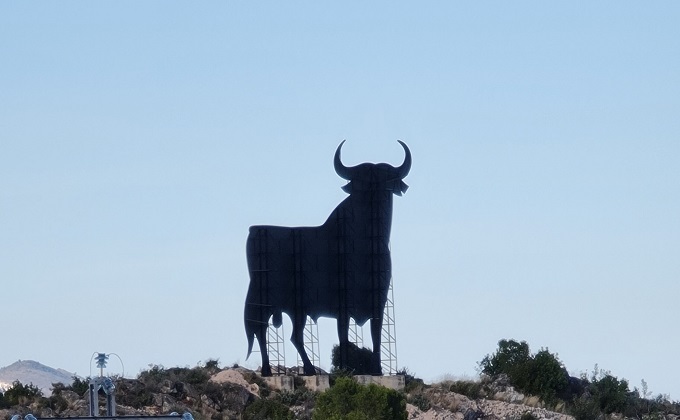For many, the Osborne Bull is one of the universal symbols of the Spanish brand and has been with us for several generations. An image with a great cultural and symbolic meaning. For others, it is a simple commercial brand of the Osborne Group
The Osborne Bull has been, it is and will be heritage, culture, sport and solidarity, as Osborne states on his website about the history of the Bull . And all because the Osborne Foundation works in multiple projects of a social nature and in the conservation of Osborne’s heritage ( more than 90 bulls). The bull has appeared in films such as “Jamón, Jamón”, in the shoes with which Rafael Nadal won the Davis Cup in 2000 and many artists such as Alejandro Sanz, Juan Duyos or Miguel Palacios, as well as urban artists have reinvented their perception of the Osborne Bull.
Of the total of the Osborne Bulls in Spain, 9 are in the Valencian Community (4 in the province of Valencia and 5 in the province of Alicante).
- Santa Pola, near the Albufera de Elche (Alicante), on the N-332, kilometer point 83.
- Monforte del Cid (Alicante), on the N-330, kilometer point 16.
- El Campello (Alicante), on the N-332, kilometer point 120.
- El Campello (Alicante), on the N-332 at kilometer 101,950.
- Benidorm, next to Avenida Costa Blanca nº2, behind the houses (coordinates 38 ° 32’16.68 ″ N 0 ° 1’21.1 ″ W or 38.5379342, -0.1896245).
- Tavernes de la Valldigna (Valencia), on the N-332, kilometer point 152.
- At the University Campus of the Polytechnic University of Valencia.
- El Rebollar (Valencia), on the N-III, Madrid highway, kilometer point 289,500.
- Villagordo del Cabriel (Valencia), on the N-III, Madrid highway, kilometer point 247,600.
In 1954, the Osborne Group commissioned the Madrid-based agency Azor Publicidad to create a commercial image to represent the brand of its new Veterano brandy, a symbol that would mainly appear on billboards at various points on the roads of Spain.
The advertising company, of which the great artist from Puerto de Santa María, Manuel Prieto Benítez was Artistic Director, designed a silhouette of a bull that, at first, was rejected by Osborne as, according to the spirits company from Cádiz, it was more appropriate for a cattle ranch.
Finally, after the insistence of the artist and creator of the bull, Osborne accepted and the first billboard of a bull was placed in May 1957 at Km.55 of the Madrid-Burgos highway, in the town of Cabanilles de la Sierra. This first silhouette of the Osborne Bull was 7 meters high, 40 square metre in area and was made of wood.
In 1994, the Ministry of Transport and Public Works, with the then Minister Josep Borrell, resolved that the 97 bulls should be removed from the Spanish landscape along with the rest of the billboards located on the edge of Spanish roads. He wished to enforce the Roads Act of 1988 that ordered the removal of visible advertising from the roads. It is at this precise moment when the silhouette lives one of its stellar moments and where its enormous popularity could be verified.
Support for the bull was clear and signatures were collected from thousands of anonymous citizens asking for clemency. Writers and columnists wrote articles on the matter in the main national newspapers asking for pardon for the bull silhouette and the controversy crossed national borders and was written about in international newspapers.
That same year, and after popular pressure, Parliament pardoned the billboard, designed by Manolo Prieto. “The artistic and cultural significance of the road bull and its integration into the Spanish landscape must be protected” said the proposal approved by the deputies, thus being excluded from the restrictions imposed by the 1988 Highway Law.
In 1998, the Supreme Court definitively pardoned the silhouette of the bull on the roads since it understood that “it has ceased to be the emblem of a brand, to become something decorative, integrated into our landscape.”
As it is a commercial logo, no company outside the Osborne Group may reproduce the image of the famous bull without authorisation.

